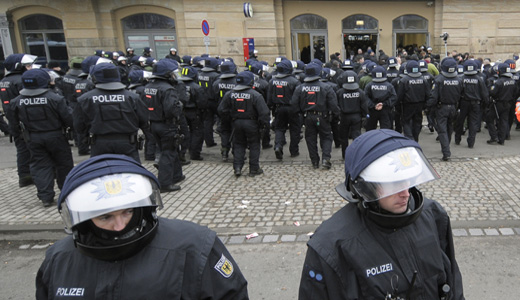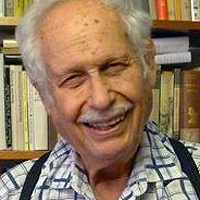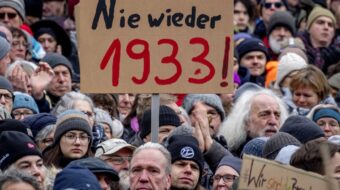
BERLIN – By sailing up the Elbe past a dozen famous castles and cathedrals, the traveler reaches Dresden, capital of Saxony in Germany’s southeastern corner, bordering Poland and the Czech Republic. In 2009, Dresden gained notoriety when there the neo-Nazi NPD party got the biggest pro-Nazi vote in all Germany, 5.6 percent, and eight deputies in the state legislature. This presence gives them a propaganda platform and a source of government euros dealt out on the basis of election returns.
And they’ve held annual “memorial marches” on the anniversary of the controversial 1945 fire-bombing of Dresden by the Allies (the British Royal Air Force and the United States Army Air Force) which killed at least 25,000 people and the resulting firestorm destroyed 15 square miles (39 square kilometers) of the city center. Playing on the strong feelings in the city, the NPD misused the commemoration by claiming that this had been Dresden’s Holocaust which had balanced out “that other one”.
Last year anti-fascists found this intolerable. Fascism is not an opinion but a crime, they said, and 10,000 people, an alliance of left-wing groups, sat down for a long day in icy weather, blocking off all streets around the station where the Nazis inside choked with helpless anger at the dramatic defeat. But the Nazis vowed to make up for it this year.
The right-wing court, in a final decision, gave the Nazis the permission they needed. At the same time, under public pressure nationally, the mayor of Dresden, a woman from the Christian Democrats, organized a human chain around the whole downtown area, 14,000 strong last year, 17,000 strong this year, joining hands for two minutes while bells tolled to commemorate the dead of 1945 and oppose misuse of their memory. It was a good measure in its way, but stopped no Nazis, who planned, after a preliminary gathering on that day, February 13th, to set their big event for February 19th, last Saturday. 7000 or more of their number would be in Dresden for a rally and marches in various areas.
This court ruling meant the anti-fascist actions to block them were only semi-legal, but even so they were decried by the right-wing parties (the CDU and Free Democrats) who rule Dresden and Saxony and always condemn “both right and left wing extremists” as equally harmful!
Just the same, over 250 anti-Nazi buses rolled toward Dresden from all over Germany, with some from neighboring countries as well. Many more came by car or train. The final number was estimated at well over 15,000, mostly but not only young people. I, surely one of the oldest, was in a bus that left Berlin at 5:30 a.m. and reached Dresden after 9. My young partners in this exercise in civil disobedience were all friendly, helpful and full of respect that an 82-year-old joined them. But none of us were respected by the police!
At the city limits sign we had to leave the buses and walk, walk and walk, well over five miles, with cordons of heavily armed and visored police at every turn, blocking us off and splitting the group into smaller and smaller units, with helicopters circling overhead and snarling, barking dogs on the ground. Some groups were met with tear gas and water cannon, but we were luckier.
Sometimes using side streets and paths through backyards, our group of about a thousand of us reached a spot within sight of Dresden’s main station where most Nazis were due to arrive. A police barricade prevented us from getting closer, and we saw nothing of them. So we simply stayed put all day, sitting or standing in the blocked-off street. It was a damp, freezing day, but people kept their good mood the whole day.
Our group came from the youth and student sections of the Left party, from youth sections of the Greens and Social Democrats, from unions, from some direct antifascist organizations, at least one atheist group, some with a sign “Queers bash the Nazis” and some anti-fascist transvestites. I also saw Turkish, Kurdish, Iranian and Chilean immigrants or exiles and quite a few anarchists with their flags.
We learned per mobile telephone that similar groups and some much larger had assembled, despite police chicanery, at other spots around the main station.
How many Nazis showed up? Estimates ranged from 800 to 3000. No one really knows since the police, to prevent pitched battles, kept them in the station just like they did in 2010.
One possible exit point was suddenly blocked by 200 young people shouting a new slogan: “Alerta! Alerta! Antifascista!” There were simply too many of us! The police saw no way of letting the Nazis go to their meeting site, where only about 40 locals waited disconsolately. Finally, totally frustrated, the Nazis gave up; about 500 took the train to Leipzig, Saxony’s second city, but were not allowed to demonstrate there.
Late that night the media reported briefly that there had been violence by a group of so-called autonomists. The main organizers of the action had prepared all of us in the buses and had stressed our non-violent methods, but there are always one or two who seem happy to provide the desired nasty headlines for the mass media. Many suspected that provocateurs had again been at work. This gave the police, who had been sent in from the most distant regions of Germany, an excuse to attack the press center of the anti-fascist demonstration in the building of the Left party, kicking in doors, hurting one person and seizing computers. They claimed they “suspected plans for violence.”
But at the end of the day as our thousands made our way through town to get to our buses (I was back in Berlin at 10.30 p.m.), we were certain that we had once again used a form of civil disobedience in the spirit of Thoreau and Martin Luther King. But also in the fighting spirit of the anti-fascist volunteers in the Spanish Civil War 75 years earlier, still using the slogan No pasaran!, They shall not pass! We had been able to prevent at least one fascist march. The Nazis remained a hateful menace, but had suffered one more real defeat and would perhaps give up on Dresden in future. It was a hard day, especially for elder participants like me, but more than satisfying.
Photo: Police officers blocking the entrance to the the train station in Dresden, Feb. 19. Pawel Sosnowski / AP












Comments